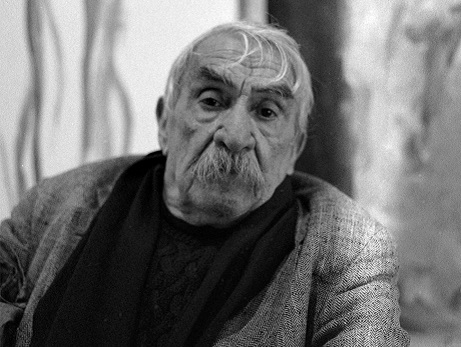Biography
Theodoros Stamos was born in New York in 1922 to an eight-member family of Greek immigrants. Since his adolescence, he was interested in art and in 1936, with a scholarship and the additional funds of working as a model and elevator operator, he attended evening sculpture classes at the American Artists School. This is where he met Joseph Solman who advised him to turn towards painting. In the following years, Stamos focused on the study of painting while making a living in various ways, but mainly as a frame maker from 1941 to 1948. He came in contact with great personalities of American and European vanguard who lived in New York during this period, such as Barnett Newman, Mark Rothko, Arshile Gorky and Fernand Léger. In 1943, he held his first solo exhibition at the Wakefield Gallery and Bookshop, owned by historic art dealer Betty Parsons, with whom he would continue to collaborate until 1957. His earliest works were influenced by Milton Avery and the primitivism of Henri Rousseau and, since the mid-1940s, he shifted towards a biomorphism of a surrealistic origin. In 1948-1949, Stamos traveled to Europe and, in the midst of the Greek civil war, he visited Greece for the first time. He spent a great deal of time in France where, with the help of Christian Zervos, he became acquainted with the artistic community and with personalities such as Pablo Picasso, Alberto Giacometti and Constantin Brâncuși. Since in the early 1950s, Stamos took his first abstract steps by incorporating gestural painting elements with references to oriental calligraphy that gradually led him to his characteristic color fields. In 1950, he taught at Black Mountain College, while he and 17 other artists participated in the artists’ protest movement against the jury of the Metropolitan Museum of Art. The informal group included, inter alia, Mark Rothko, Jackson Pollock, Robert Motherwell, William Baziotes, Barnett Newman, Clyfford Still and Willem de Kooning and went down in history as The Irascible Eighteen. From 1958 to 1970, Stamos collaborated with André Emmerich’s gallery. In 1970, he settled in Lefkada and began working on his characteristic series Endless Fields, the first of which he presented at the Marlborough Gallery in New York in 1972. His rising artistic career was interrupted that same year as the scandal known as the Rothko case broke out: following Mark Rothko’s suicide in 1970, his assets managers, including Stamos, found themselves involved in a multifaceted legal dispute between the artist’s heirs and Marlborough Gallery. Although he was undoubtedly one of the pioneers of abstract expressionism, the negative outcome of the trial significantly reduced his popularity in the United States. He continued exhibiting in New York, collaborating with Louis K. Meisel Gallery and Kouros Gallery, but also in Europe and Greece. His works can be found in collections of major museums such as the Metropolitan Museum of Art, the Art Institute of Chicago, the Whitney Museum of Art, the Smithsonian American Art Museum and the MoMA in the United States as well as the Museum Moderner Kunst in Vienna. In 1975, he made a large donation to the National Gallery – Alexandros Soutsos Museum. He died in Ioannina in 1997.



